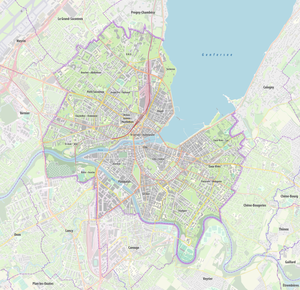Pont de la Coulouvrenière
| Pont de la Coulouvrenière | ||
|---|---|---|
(c) Patrick Nouhailler's…, CC BY-SA 3.0 | ||
| Nutzung | Strassenbrücke | |
| Querung von | Rhône | |
| Ort | Genf | |
| Konstruktion | Betonbogenbrücke | |
| Gesamtlänge | 150 m | |
| Breite | 26,20 m | |
| Längste Stützweite | 40 m | |
| Eröffnung | 1857 / 1896 | |
| Lage | ||
| Koordinaten | 499756 / 117858 | |
Die Pont de la Coulouvrenière ist eine Brücke über die Rhône in Genf, Schweiz. Sie verbindet die nördlich der Rhône gelegenen Stadtviertel und insbesondere den Hauptbahnhof Genève – Cornavin mit den Stadtvierteln im Süden des Flusses, insbesondere mit der Altstadt Cité. Sie ist nach der Pont du Mont-Blanc eine der wichtigsten Strassenbrücken Genfs, die auch von vier Trambahnlinien benutzt wird.
Lage
Sie liegt zwischen der Ile (Insel) und dem früheren Bâtiment des Forces motrices, der heutigen Salle Théodore Turrettini. Sie überquert die von der Ile getrennten Arme der Rhône sowie die Fussgängerpromenade und den Quai du Seujet / Quai Turrettini am Nordufer des Flusses. Es gibt Treppen hinab zu den Quais und eine Treppe in der Mitte der Ostseite hinunter zur Promenade des Lavandières und zur Place de l'Ile.
Geschichte
Die erste, 1857 eröffnete Brücke bestand aus einer auf zehn Jochen gelagerten Eisenkonstruktion,[1] die jedoch für dampfbetriebene Trambahnen zu schwach war.

Auf Betreiben des Stadt- und Verwaltungsrates Théodore Turrettini wurde daher 1894 ein Neubau beschlossen, wobei man sich nach der Diskussion verschiedener Bauweisen für eine Bogenbrücke aus Beton mit einer Verkleidung aus Natursteinen entschied. Der 1895 begonnene Bau wurde rechtzeitig zur Landesausstellung am 27. April 1896 eröffnet. 1970 wurde die Brücke erweitert, um breitere Trottoirs anlegen zu können. 1995 erhielt sie wieder Trambahngleise und 2001 den Metallsteg zur Promenade des Lavandières.
Technische Beschreibung
Die insgesamt 150 m lange Brücke hat zwei grosse, 40 m weite Segmentbögen über die beiden Arme der Rhône, einen Mittelpfeiler mit einem kleinen Rundbogen für die Fussgängerverbindung zwischen der Ile und der Salle Théodore Turrettini und einen Korbbogen über die Uferstrasse. Bei der Diskussion der anzuwendenden Bauweisen waren auch Verfahren nach Monier und Hennebique geprüft worden, man entschied sich jedoch für eine reine Betonkonstruktion mit Dreigelenkbögen nach dem von Karl von Leibbrand entwickelten System.[2] Die Pont de la Coulouvrenière gehört damit zu den ersten Dreigelenkbogenbrücken aus Beton. Am linken Rhône-Ufer musste die Brücke auf rund 400 Pfählen gegründet werden, sonst war der Boden ausreichend tragfähig für die Belastung von 3,5 kg/cm². Sand und Kies wurden der Arve entnommen und im Verhältnis 5:8 gemischt. Pro Kubikmeter Beton wurden je nach Belastung zwischen 425 kg und 200 kg Zement verwendet. Mit Hilfe damals moderner Mischmaschinen konnten bis zu 200 m³ Beton pro Tag eingebaut werden.[2] Die 1970 angefügten, auf eine Breite von insgesamt 26,20 m auskragenden Gehwege wurden in Stahlbetonbauweise ausgeführt.
Weblinks
Einzelnachweise
- ↑ Pont de la Coulouvrenière 1894
- ↑ a b Über den Neubau der Coulouvrenière-Brücke in Genf. Referat über den Vortrag von Prof. W. Ritter vor dem Zürcher Ingenieur- und Architekten-Verein in der VIII. Sitzung vom 4. März 1896. In: Schweizerische Bauzeitung vom 4. April 1896, Heft 14, S. 100 f; auf e-periodica.ch (PDF; 1,8 MB)
Auf dieser Seite verwendete Medien
Autor/Urheber: Internet Archive Book Images, Lizenz: No restrictions
Identifier: peopleswarbookhi00mill (find matches)
Title: The people's war book; history, cyclopaedia and chronology of the great world war
Year: 1919 (1910s)
Authors: Miller, J. Martin (James Martin), b. 1859 Canfield, Harry S. (from old catalog), joint author Plewman, William Rothwell, 1880- (from old catalog) Foch, Ferdinand, 1851-1929 Lloyd George, David, 1863-1945 United States. President (1913-1921 : Wilson)
Subjects: World War, 1914-1918 World War, 1914-1918
Publisher: Cleveland, O., The R.C. Barnum co. Detroit, Mich., The F.B. Dickerson co. (etc., etc.)
Contributing Library: The Library of Congress
Digitizing Sponsor: Sloan Foundation
View Book Page: Book Viewer
About This Book: Catalog Entry
View All Images: All Images From Book
Click here to view book online to see this illustration in context in a browseable online version of this book.
Text Appearing Before Image:
'
Text Appearing After Image:
-a a Oi « (U .—O O Constitution of the League of Nations THE PREAMBLE. In order to promote international co-operation and to achieve internationalpeace and security, by the acceptance ofobligations not to resort to war, by the pre-scription of open, just and honorable rela-tions between nations, by the firm, estab-lishment of the understandings of inter-national law as to actual rule of conduct,among governments, and by the mainte-nance of justice and a scrupulous respectfor all treaty obligations in the dealings oforganized peoples with one another, thehigh contracting parties agree to this cov-enant of the league of nations. (In the original preamble the last sen-tence read, Adopt this constitution in-stead of agree to this covenant.) ARTICLE L The original members of the league ofnations shall be those of the signatorieswhich are named in the annex to this cove-nant and also such of those other statesnamed in the annex as shall accede withoutreservation to this covenant. Such ac
Note About Images




